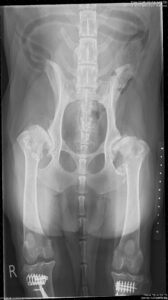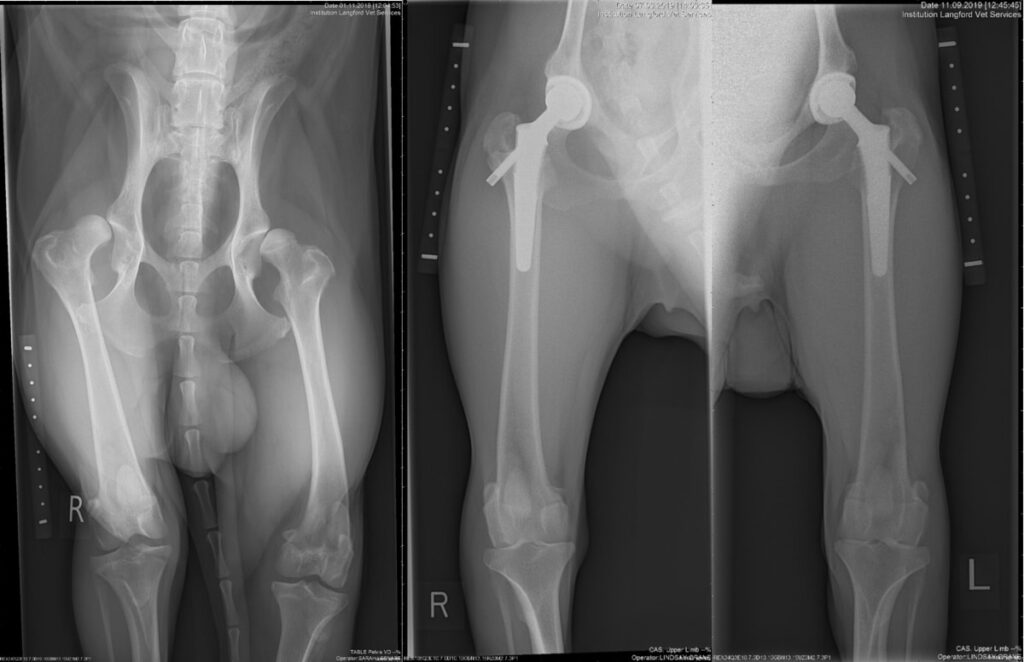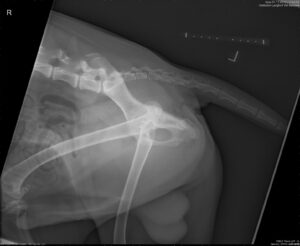

Pet 101
When Should I Consider Total Hip Replacement for My Arthritic Dog or Cat?
This is a question a lot of vets or owners are facing when treating a dog with hip dysplasia. Surgical options are becoming more accessible both in terms of availability and financially. This, along with total joint replacements now being commonly performed in humans raises awareness of the treatment options for hip osteoarthritis.
When considering total hip replacement there are numerous factors to consider. Common questions include:
- Does my dog/cat need a total hip replacement now?
- Could my dog/cat’s quality of life be improved?
- When is a total hip replacement justified for my dog/cat?
- Is surgery worth the risks?
To answer these questions fully, the following points need to be considered:
HISTORY
Clinical signs often associated with hip dysplasia are presented in Table A. These symptoms are more obvious when the hindlimb lameness is more pronounced on one side.
| Young dogs (6 to 18 months) |
|
| Older dogs |
|
Table A: Non-exhaustive list of clinical signs reported for dogs presented with hip dysplasia
When considering younger dogs, identifying signs of pain may be more challenging. Younger dogs are usually good at hiding their pain. Young dogs usually keep playing and exercising despite obvious discomfort or pain. If bilateral, we do not have any point of comparison between the legs. In these cases, a therapeutic trial of an anti-inflammatory drug can be useful to demonstrate if discomfort is present. Dogs are often presented for abnormal gait
Clinical /orthopaedic exam
The first part of the orthopaedic exam will focus on the gait analysis. As the condition is often bilateral, a unilateral hindlimb lameness characterised by an asymmetry of the vertical displacement of the pelvis is rarely seen. It is however common for one limb to be more affected than another, so subtle gait asymmetries may be present. Common signs include a swinging gait with bunny hopping gait while running or at trot on the most affected dogs. Dogs with subluxated hips tend to walk with a more abducted gait. Often dogs slightly shift laterally the most affected hindlimb.
Manipulation will typically elicit pain during hip extension and abduction in dysplastic or arthritic joints.
Other causes of hindlimb lameness must be ruled out during physical examination. It is not uncommon to find other causes of hindlimb lameness in addition to hip dysplasia. That should be addressed prior to considering hip surgery. Conditions to exclude include cranial cruciate ligament disease, lumbo-sacral disease, muscular disease, degenerative myelopathy etc…
Are there alternative surgical options to total hip replacement?
Surgical options available for hip dysplasia that modify the hip anatomy can be considered in young dogs. Juvenile pubic symphysiodesis has been described in dogs that are younger than 24 weeks (however are most effective if performed between 15 and 18 weeks of age) and demonstrate hip laxity on orthopaedic examination and distraction radiography. This surgery has been associated with a reduced risk of developing hip osteoarthritis in puppies with increased hip laxity (1,2,3).
A second surgery to consider in young dogs is the double or triple pelvic osteotomy. These techniques can be considered in dogs from 6– to 10-month of age demonstrating mild hip instability (identified through the Ortolani test), clinical signs of hip dysplasia, and no radiographic evidence of osteoarthritis (+/- arthroscopy if available).
It is important to note that neither of these procedures (juvenile pubic symphysiodesis or triple pelvic osteotomy) eliminates the hip joint laxity characteristic of hip dysplasia and the progression of degenerative changes can still occur (3,4).
Femoral head and neck excision is considered a salvage option that has been traditionally used for the treatment of painful hip joints. Femoral head and neck excision is usually not recommended in large breed dogs unless all the aspects of conservative management have been attempted and total hip replacement is not an option. (5).
When performed in small breed dogs femoral head and neck excision surgery can provide better outcomes than in large dogs. It could look satisfactory from an owner’s perspective, particularly if an appropriate post-operative physiotherapy regime is employed. However, the results are less predictable (and can include persistent lameness) and the hip function will not be normal (having a decreased range of motion, proximal displacement etc..). The difference in outcome between femoral head and neck excision and total hip replacement is less obvious in small breeds, however, the latter option is becoming increasingly recognised as offering improved outcomes and should therefore be considered gold standard (5).
Response to conservative management
The response to conservative management is an important part of the decision-making. Upon instigation of a suitable conservative treatment regime and should a dog be able to have normal activity without clinical signs, surgery is unlikely to be recommended. Conservative management usually requires a multimodal approach, with an administration of pain killers on-demand
Progression of clinical signs:
Many young dogs (between 6 and 18 months) will tend to improve with conservative management. In young dogs, a significant amount of the pain exhibited is thought to originate from instability of the hip joint and stretching of the soft tissue (joint capsule and round ligament). When skeletal maturity is reached, the dysplastic joint capsule thickens and instability may be reduced. This can be seen clinically as a reduction in the amount of pain in affected joints and an improvement in the clinical signs. Osteoarthritis will however start to develop and progress.
In older dogs, the main cause of pain originates from osteo-arthritis and erosion of the articular cartilage. Pain from osteoarthritis and cartilage erosion can however also be seen in some young dogs and is often secondary to the abnormal load distribution resulting from hip subluxation.
Young dogs with severe hip dysplasia are likely to improve with conservative management in the short–term and may reach a point where only mild to moderate discomfort is present and can allow a reasonable quality of life. However, these dogs are unlikely to be pain-free without any treatments and are likely to see a progressive worsening of their condition with ageing. This worsening is usually subtle and takes some time to be picked up as it is bilateral and progresses slowly. These patients may therefore benefit from an early decision to perform total hip replacement surgery.
Even though there is limited association between radiographic and clinical signs of dysplasia, when both are severe, dogs are likely to benefit from early total hip replacement (Figure 1 and 2).
Expectation
Many dog owners do not tolerate the idea of having their pet suffering from discomfort or pain even if the dog’s quality of life is only mildly affected by hip dysplasia and osteoarthritis. This is particularly the case if you have experienced osteoarthritic pain yourself. A dog’s total hip replacement is expected to last for the life of the patient, some owners are therefore keen to go straight for total hip replacement and do not want to wait for a degradation of their dog’s condition. A common question we had is: “Why should I have my dog medicated and wait until they get worse while we could have them pain-free from now with a total hip replacement?”
Some owners may also expect a high level of performance from their dog and want them to be able to work (e.g. gun dog, guard dog) or go for intensive activities (e.g. long walks, run) without restriction.
Risk versus benefits of the surgery
The surgical risks should be considered as informed consent is essential. The benefit of having a dog pain-free and back to normal activity after a total hip replacement is easy to understand. The risk of complications requiring further surgery is low but not insignificant (5 to 10%) (4,5,6). Approximately 2.5 to 5% of dogs may eventually have their total hip replacement explanted resulting in a femoral head and neck excision. The cost and morbidity of complications therefore need to be discussed.
Conclusion
THR is becoming an increasingly performed surgery and in most cases restores normal hip function and an excellent clinical outcome. Appropriate patient selection and owner counselling is important prior to performing surgery and surgery should be considered early in the course of the disease. Surgery can be performed in both young and old dogs and the decision to perform surgery as well as its timing will be influenced by owner’s expectations and sensitivity.
Figure 1: Ventro-dorsal X-rays of a 6-year-old springer spaniel. Hip remodelling and osteo-arthritis could be easily appreciated. Clinically, the dog was only moderately affected. However, his owners reported a dramatic improvement of his level of activity after bilateral total hip replacement
Figure 2: Ventro-dorsal and lateral X-rays of a 9-month-old Labrador pelvis with severe hip laxity. Luxation of the hip can be noticed on the lateral view. The dog could only walk for 10 to 15 minutes and tended to shift his weight towards his front limbs. This dog had a R total hip replacement (luxated hip on lateral pelvis X-rays) performed when he was 10-month-old and the L hip 6 weeks later. At that stage the L hip was also luxated. Implants used are uncemented (Biomedtrix, BFX with lateral bolt)
References
- A J. Patricelli, R. T. Dueland, W.M. Adams et al. Juvenile Pubic Symphysiodesis in Dysplastic Puppies at 15 and 20 Weeks of Age Vet Surg 2002; 31(5): 435-444
- A. Bernarde Juvenile Pubic Symphysiodesis and Juvenile Pubic Symphysiodesis Associated with Pectineus Myotomy: Short‐Term Outcome in 56 Dysplastic Puppies Vet surg 2010; 39 (2): 158-164
- P. A. Manley, W. M. Adams,K. Danielson et al. Long-term outcome of juvenile pubic symphysiodesis and triple pelvic osteotomy in dogs with hip dysplasia JAVMA 2007, 230 (2): 206-210
- A.L. Johnson, C.W. Smith, G.J. Pijanowski, et al. Triple pelvic osteotomy: effect on limb function and progression of degenerative joint disease JAAHA 1998; 34 (3): 260-264.
- W. Off, U. Matis.Excision arthroplasty of the hip joint in dogs and cats. Clinical, radiographic, and gait analysis findings from the Department of Surgery, Veterinary Faculty of the Ludwig-Maximilians-University of Munich, Germany. Vet Comp Orthop Traumatol 2010; 23: 297–305.
- D. W. Hummel, O. I. Lanz, S. R. Were Complications of cementless total hip replacement A retrospective study of 163 cases. Vet Comp Orthop Traumatol 2010; 23(06): 424-432
- T J. Gemmill, J Pink, A Renwick Hybrid Cemented/Cementless Total Hip Replacement in Dogs: Seventy‐Eight Consecutive Joint Replacements Vet Surg 2011; 40 (5)
- J. Dyce,E. R. Wisner, Q. Wang et al. Evaluation of Risk Factors for Luxation After Total Hip Replacement in Dogs Vet Surg nov 2000:29 (6): 532
More Posts




What is Rehabilitation?
Physiotherapy/rehabilitation is commonplace to help people recover from injuries and surgeries.

PennHip
The program was established at the University of Pennsylvania School of veterinary Medicine by Dr. Gail Smith in 1993.

 3899 8999
3899 8999








